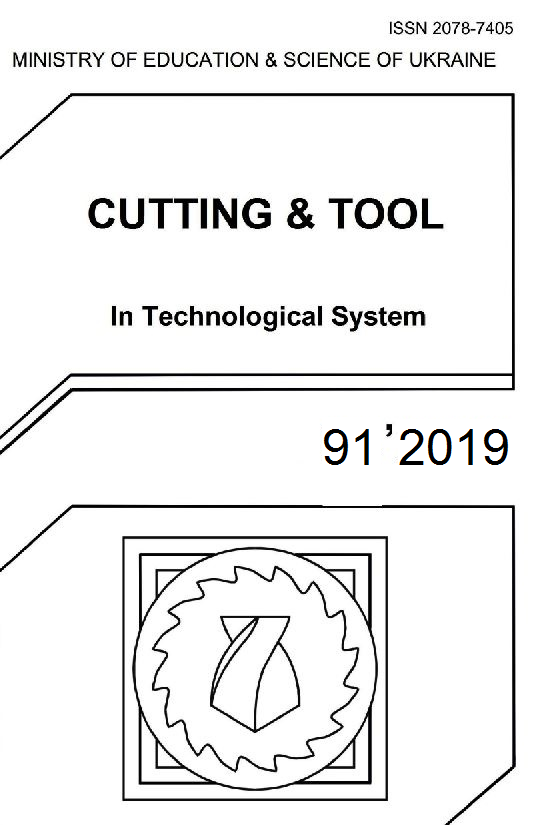IMPROVEMENT OF PHYSICAL AND MECHANICAL CHARACTERISTICS OF SYNTHETIC DIAMONDS SYNTHESIZED IN DIFFERENT GROWTH SYSTEMS TO IMPROVE THE EFFICIENCY OF THE DIAMOND STONETREATMENT AND DRESSING TOOLS
DOI:
https://doi.org/10.20998/2078-7405.2019.91.11Keywords:
synthetic diamond grinding powders, stonetreatment and the ruling tool, physicomechanical characteristics, uniformity on strength, the contents of intracrystal impurity.Abstract
The hysicomechanical properties grinding powders the synthetic diamond used at equipment tool very big influence is rendered on an overall performance diamond stonetreatment and the precision ruling tool. Properties grinding powders diamond, in turn, are caused by technologies of synthesis, enrichment, processing, classification in the sizes and the form, sorting that promotes reception of powders with the set properties. As a result of perfection of process of synthesis by a number of conducting foreign firms can be made are received. Synthetic diamonds with very high durability of which high-strength powders of diamond of marks АС200–АС400. Researches carried out on diamonds of grit sizes 400/315 different marks synthesized in systems: Ni-Mn-C, Fe-Ni-C, Fe-Co-C. As a result of the executed researches it is shown, that hysicomechanical characteristics diamond grinding powders (strength and thermostability), synthesized in different ростовых systems Ni-Mn-C, Fe-Co-C and Fe-Ni-C, with the big contents of intracrystal impurity and inclusions (it is more twice ) in comparison with diamonds with the smaller contents – are reduced from 3 up to 5 times. For increase of efficiency of division grinding powders the synthetic diamond, the ferroalloys synthesized with application, it is developed a way of division of diamonds on deficiency of their surface, by selective drawing electrowire very fine disperse powder particles and due to forces of adhesion of their fastening on a surface of grains of a powder (for amplification of natural electric properties), that allows to divide a grain of diamond in an electric field on 5-7 fractions differing among themselves on strength characteristics and to improve selectivity of their division on strength characteristics. Use in the tool diamond grinding powders with high uniformity on durability will allow to raise efficiency diamond stonetreatment and the ruling tool.References
Lavrіnenko V.І., Novіkov M.V. Nadtverdі abrazivnі materіali v mehanoobrobtsі: entsiklopedichniy dovіdnik. – Kyiv: ІNM іm. V.M. Bakulya NAN Ukraїni, 2013. – 456 p.
Novikov N.V., Nevstruev G.F., Ilnitskaya G.D. i dr. Otsenka kachestva poroshkov sverhtverdyih materialov. CHast 1. Teoreticheskie osnovyi metoda otsenki harakteristik kachestva // Sverhtverdyie materialyi. 2006. № 5. pp. 74-83. CHast 2. Prakticheskoe primenenie novogo metoda otsenki harakteristik kachestva // Sverhtverdyie materialyi. 2006. № 6. pp. 58-67.
Fizicheskie svoystva almaza. Spravochnik. – Kyiv: Naukova dumka, 1987. –pp. 85-89.
Ilnitskaya G.D. Vliyanie strukturyi kristallov almaza na fiziko-mehanicheskie svoystva almaznyih poroshkov. Nadtverdі materіali: stvorennya ta zastosuvannya. ІNM NAN Ukraїni, Kyїv. – 2007. pp. 189-196.
Ilnitskaya G.D., Bogatyireva G.P., Nevstruev G.F. Poluchenie vyisokokachestvennyih almaznyih shlifporoshkov // Sb. nauch.tr. «Sintez, spekanie i svoystva sverhtverdyih materialov», ISM NAN Ukrainyi. – Kyiv, 2005. – pp. 63-71.
Novikov N.V., Shulzhenko A.A., Bogatyreva G.P., Sokolov A.N, Nevstruev G.F., Ilnitckay G.D. Uniformity of superhard material grinding powders // NATO Innovative Superhard Materials and Sustainable Coatings for Advanced Manufacturing, 2005. – pp. 391-402.
Patent № 25515 Ukraїni, MPK B03C 7/00, B03C 1/00 № 200703803; Sposіb rozpodіlu zernistogo materіalu za defektnіstyu poverhnі zeren. / Novіkov M.V., Bogatirova G.P., Nevstruєv G.F., Іlnitska G.D. – Zayavl. 05.04.2007; Opubl.10.08.2007. Byul. № 12.
Downloads
Published
Issue
Section
License
Copyright Notice
Authors who publish with this Collection agree to the following terms:
1. Authors retain copyright and grant the Collection right of first publication with the work simultaneously licensed under a Creative Commons Attribution License that allows others to share the work with an acknowledgement of the work's authorship and initial publication in this Collection.
2. Authors are able to enter into separate, additional contractual arrangements for the non-exclusive distribution of the Collection's published version of the work (e.g., post it to an institutional repository or publish it in a book), with an acknowledgement of its initial publication in this Collection.
3. Authors are permitted and encouraged to post their work online (e.g., in institutional repositories or on their website) prior to and during the submission process, as it can lead to productive exchanges, as well as earlier and greater citation of published work.

